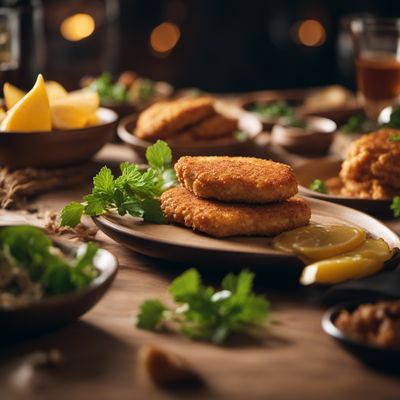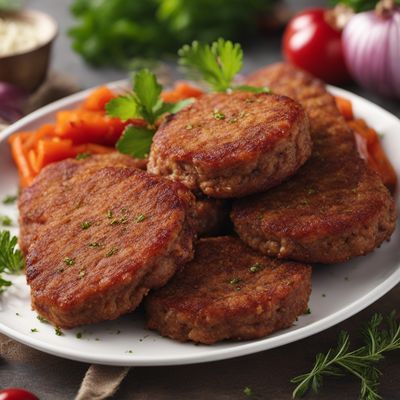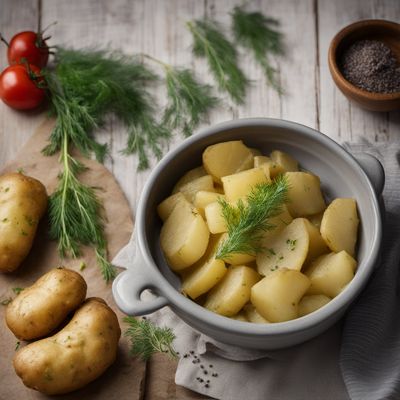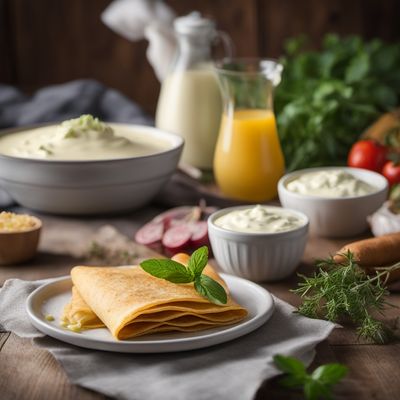
Recipe
Molecular Żymła
The Molecular Twist on Traditional Polish Żymła
4.1 out of 5
Experience the innovative fusion of traditional Polish cuisine with the avant-garde techniques of molecular gastronomy in this unique recipe for Molecular Żymła. Combining the rich flavors of the original dish with the modern flair of molecular gastronomy, this dish is sure to impress both your taste buds and your guests.
Metadata
Preparation time
45 minutes
Cooking time
2 hours
Total time
2 hours and 45 minutes
Yields
4 servings
Preparation difficulty
Medium
Suitable for
Omnivore, Gluten-free, Low-carb, High-protein, Molecular gastronomy enthusiasts
Allergens
Dairy, Meat
Not suitable for
Vegetarian, Vegan, Dairy-free, Egg-free, Nut-free
Ingredients
In the original Polish Żymła, the meat is typically slow-cooked and served in larger pieces, accompanied by boiled potatoes and sauerkraut. In the molecular adaptation, the meat is transformed into spheres using spherification, and the potatoes are transformed into a light and airy foam. The dish is also enhanced with the addition of beetroot gel and crispy onion crumbs, adding new layers of flavor and texture. We alse have the original recipe for Żymła, so you can check it out.
-
500g (1.1 lb) pork or beef, cut into small cubes 500g (1.1 lb) pork or beef, cut into small cubes
-
10g (0.35 oz) sodium alginate 10g (0.35 oz) sodium alginate
-
500ml (2 cups) water 500ml (2 cups) water
-
5g (0.18 oz) calcium lactate 5g (0.18 oz) calcium lactate
-
500g (1.1 lb) potatoes, peeled and diced 500g (1.1 lb) potatoes, peeled and diced
-
250ml (1 cup) heavy cream 250ml (1 cup) heavy cream
-
10g (0.35 oz) nitrous oxide (N2O) chargers 10g (0.35 oz) nitrous oxide (N2O) chargers
-
200g (7 oz) beetroot, cooked and pureed 200g (7 oz) beetroot, cooked and pureed
-
5g (0.18 oz) agar-agar 5g (0.18 oz) agar-agar
-
50g (1.8 oz) crispy fried onions 50g (1.8 oz) crispy fried onions
-
Salt and pepper to taste Salt and pepper to taste
Nutrition
- Calories: 450 kcal / 1884 KJ
- Fat: 25g (Saturated Fat: 12g)
- Carbohydrates: 30g (Sugars: 5g)
- Protein: 30g
- Fiber: 4g
- Salt: 2g
Preparation
-
1.In a blender, combine the meat cubes, sodium alginate, and water. Blend until smooth and strain the mixture to remove any lumps. Set aside.
-
2.In a separate bowl, dissolve the calcium lactate in 500ml (2 cups) of water. Stir until fully dissolved.
-
3.Using a spoon or a syringe, carefully drop small portions of the meat mixture into the calcium lactate solution. Allow the spheres to sit in the solution for 2-3 minutes to set. Remove the spheres from the solution and rinse them gently with water. Set aside.
-
4.In a saucepan, cook the diced potatoes in salted water until tender. Drain and transfer to a blender.
-
5.Add the heavy cream and nitrous oxide chargers to the blender with the potatoes. Blend until smooth and creamy. Season with salt and pepper to taste.
-
6.In a separate saucepan, combine the beetroot puree and agar-agar. Bring to a boil and simmer for 2 minutes, stirring constantly. Remove from heat and let it cool slightly.
-
7.To assemble the dish, spoon the potato foam onto serving plates. Place the meat spheres on top of the foam. Drizzle the beetroot gel over the spheres and sprinkle with crispy fried onions.
-
8.Serve immediately and enjoy the unique flavors and textures of Molecular Żymła.
Treat your ingredients with care...
- Pork or beef — Choose a tender cut of meat for best results in creating the meat spheres.
- Sodium alginate — Ensure that the sodium alginate is fully dissolved in the water to achieve a smooth meat mixture.
- Nitrous oxide chargers — Use caution when handling nitrous oxide chargers and follow the manufacturer's instructions carefully.
- Beetroot — Use cooked and pureed beetroot for the gel to achieve the desired consistency.
- Agar-agar — Agar-agar sets quickly, so work efficiently when making the beetroot gel.
Tips & Tricks
- For a vegetarian version, substitute the meat with marinated tofu cubes and adjust the cooking time accordingly.
- Experiment with different flavors for the potato foam by adding herbs or spices to the puree.
- Add a touch of acidity to the beetroot gel by incorporating a squeeze of lemon juice.
- For an extra crunch, garnish the dish with toasted pine nuts or pumpkin seeds.
- Serve Molecular Żymła as a starter or main course, accompanied by a fresh green salad.
Serving advice
Serve Molecular Żymła on individual plates to showcase the elegant presentation. Encourage your guests to savor each element of the dish separately or combine them for a burst of flavors and textures in every bite.
Presentation advice
Create an artistic presentation by arranging the meat spheres in a visually appealing pattern on top of the potato foam. Drizzle the beetroot gel in a decorative manner and sprinkle the crispy fried onions strategically for added visual interest.
More recipes...
For Polish cuisine » Browse all
For Molecular gastronomy » Browse all

Molecular Gastronomy Cochinita Pibil
The Transformed Cochinita Pibil: A Molecular Gastronomy Delight

Molecular Gastronomy Acarajé
The Gastronomic Revolution: Molecular Acarajé

Molecular Papricaș de Pește
The Molecular Transformation of Papricaș de Pește: A Fusion of Hungarian Tradition and Molecular Gastronomy
More Polish cuisine dishes » Browse all

Zrazy wołowe zawijane
Stuffed Beef Rolls
Zrazy wołowe zawijane is a traditional Polish dish that is perfect for a hearty meal. It is a beef roll-up that is stuffed with bacon, onions, and pickles.

Kotlet z piersi kurczaka
Chicken Breast Cutlet
Kotlet z piersi kurczaka is a popular Polish dish that translates to "chicken cutlet" in English. It is a simple yet delicious dish that is...

Żurek
Sour rye soup
Żurek is a traditional Polish soup made with fermented rye flour and meat. It has a sour taste and is often served with boiled eggs and sausage.





